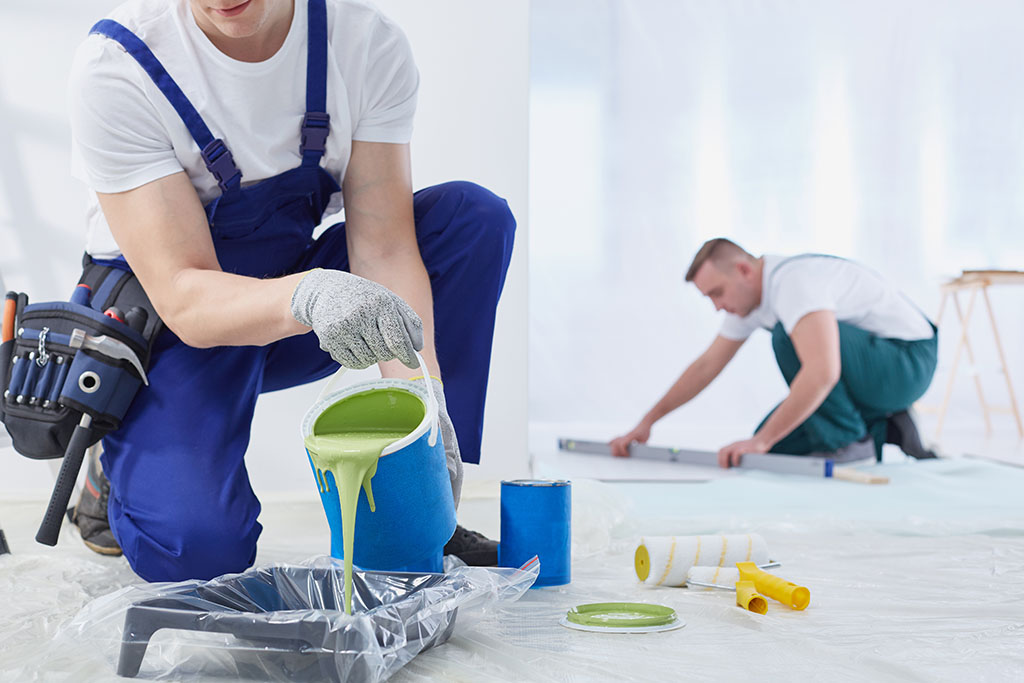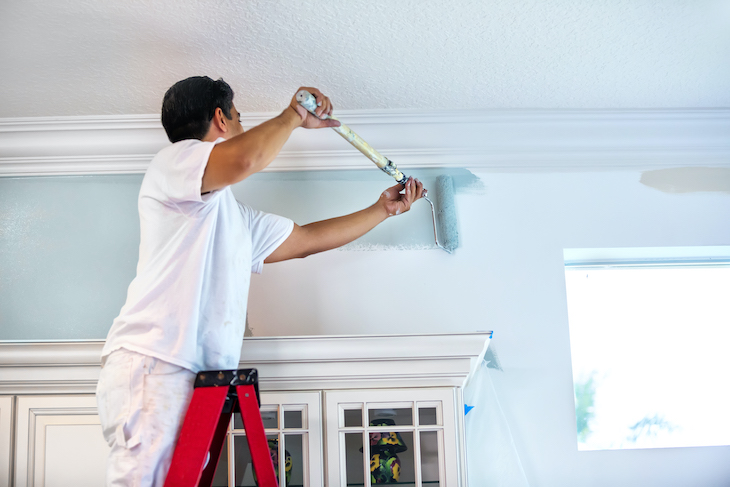Exploring the Various Sorts Of Paint: An Overview for each Project
Discovering the different kinds of paint is necessary for accomplishing the wanted end result in any kind of project. From water-based choices that offer ease to oil-based paints understood for their durability, each selection has its qualities. Specialized paints can add unique appearances or surfaces, while environmentally friendly alternatives provide to those looking for sustainability. Recognizing these distinctions can greatly influence the success of a painting undertaking. What aspects should one consider when making the right choice?
Comprehending Paint Types: Oil-Based vs. water-based
Paint types can markedly affect a project's outcome, and understanding the distinctions between oil-based and water-based paints is important for educated decision-making. Water-based paints, frequently described as latex paints, are composed of water as the main solvent. They dry promptly, release fewer unstable natural compounds (VOCs), and are very easy to tidy up with soap and water. This makes them a popular option for indoor applications and atmospheres where air top quality is a concern.
In comparison, oil-based paints use natural solvents, giving a resilient, shiny coating ideal for surfaces subjected to damage, such as trim and cupboards. They take longer to completely dry, need mineral spirits for cleaning, and have a more powerful smell. corpus christi tx paint shop. Choosing between these 2 kinds relies on the specific demands of the project, thinking about aspects such as wanted coating, application environment, and ease of maintenance. Each type has distinctive advantages and limitations, directing the choice procedure
The Complete Issues: Picking Between Matte, Satin, and Gloss
When choosing a paint surface, the option between matte and glossy choices substantially influences both looks and capability. Matte coatings supply a refined, non-reflective appearance that can conceal surface area flaws, while shiny coatings give durability and ease of cleaning. Recognizing the advantages and factors to consider of each can help in making a notified decision for any kind of painting project.
Matte End Up Advantages
Although many property owners discuss the advantages of various finishes, matte paint supplies distinctive advantages that make it a prominent option for both interior and exterior applications. Among the main benefits of matte finish is its capacity to hide surface area flaws, developing a smoother look on walls. This high quality is particularly useful in older homes or areas with irregular surface areas. Additionally, matte paint takes in light as opposed to reflecting it, which can boost the aesthetic of an area by offering an extra soft and innovative appearance. Additionally, matte finishes are commonly easier to repair than glossier options, as they can blend extra flawlessly when used over existing paint. In general, matte paint is a superb selection for those seeking a fine-tuned and sophisticated surface.
Glossy End Up Factors To Consider
A glossy finish can substantially alter the understanding of a space, supplying a reflective and smooth high quality that boosts both shade vibrancy and light within a room. This finish is typically preferred for high-traffic locations and surfaces like bathroom and kitchens, where longevity and ease of cleaning are crucial. Its reflective nature can highlight imperfections on wall surfaces, making proper surface area preparation essential. Glossy paints likewise often tend to show spots and finger prints a lot more easily, demanding normal maintenance. Furthermore, illumination plays a considerable function; in bright environments, a glossy finish might create glare, impacting the overall visual. Subsequently, mindful factor to consider of the details application and environment is necessary when choosing a shiny coating for any type of job.
Specialized Paints: When to Utilize Textured or Chalk Paint
Specialty paints, such as textured and chalk paint, deal special aesthetic and practical advantages that can improve various surfaces. Distinctive paint is excellent for producing depth and measurement on walls, concealing blemishes while adding a three-dimensional feeling. It is particularly advantageous in high-traffic locations where sturdiness and visual passion are necessary.

Both kinds of specialty paints can transform spaces, but picking the appropriate one relies on the preferred impact and surface requirements. Textured paint might match bigger areas, while chalk paint can revitalize smaller sized products, showcasing imagination and personal style in any kind of job.
Outside Paints: Safeguarding Your Surfaces From the Components
Outside paints are vital for protecting surfaces versus different weather problems. Recognizing their weather condition resistance attributes, appropriate surface prep work demands, and effective application strategies can considerably enhance resilience and performance. This section will certainly outline key factors to consider for selecting and making use of outside paints properly.
Climate Resistance Features
Climate resistance is a necessary function of exterior paints, as it identifies just how well surfaces can hold up against the extreme elements of nature. High-grade outside paints are created to resist damages from UV rays, moisture, and temperature variations. UV resistance assurances colors stay vivid in time, protecting against fading and discoloration. Wetness resistance protects against mold and mold, which can jeopardize the stability of surface areas. Additionally, paints with exceptional temperature level resistance can contract and expand without breaking, maintaining their protective top qualities. When picking outside paints, it is important to take into account these weather condition resistance functions, as they add to the long life and sturdiness of coloured surface areas, making certain they stay cosmetically pleasing and useful despite exposure to the elements.
Surface Preparation Demands
Appropriate surface area prep work is a basic step in achieving the best results with outside paints. To ensure suitable adhesion and toughness, surface areas need to be extensively cleansed, getting rid of mold, dust, and grease. This can be accomplished utilizing a stress washer or a scrub brush with an ideal cleansing remedy. As soon as cleansed, surface areas must be checked for any type of peeling or flaking paint, which need to be scuffed away to produce a smooth foundation. Fixing any kind of holes or fractures is additionally crucial, as these can permit dampness seepage. Furthermore, sanding harsh locations advertises far better paint bond. Using a primer matched for outside use can enhance the paint's efficiency, ensuring a lasting coating that stands up to the aspects. Correct prep work is key to an effective exterior painting task.
Application Methods Tips
While applying exterior paints, it is vital to utilize efficient techniques that guarantee surface areas are well-protected against the components. First, pick the best day for paint; low moisture and mild temperature levels improve adhesion and drying out. Prepping the surface area thoroughly-- cleansing, fining sand, and priming-- guarantees far better paint adhesion and resilience. Making use of premium brushes or rollers can give a smoother finish, while spray paint might cover large areas successfully. Using paint in thin, also coats stops runs and drips. It is advisable to comply with supplier instructions concerning drying out times in between layers. Finally, confirm appropriate air flow throughout application to facilitate drying and lessen exposure to fumes. These techniques substantially improve the longevity and effectiveness of outdoor paint.
Eco-Friendly Options: Low-VOC and Zero-VOC Paints
As consumers end up being progressively conscious of the ecological influence of their selections, low-VOC and zero-VOC paints have emerged as popular alternatives. These paints are formulated to include fewer volatile natural substances (VOCs), which are chemicals that can vaporize right into the air and add to air contamination and illness. Low-VOC paints commonly have a limited amount of VOCs, while zero-VOC paints have negligible degrees, making them more secure for both interior and outside use.
The benefits of using low-VOC and zero-VOC paints extend past ecological factors to consider; they likewise improve indoor air top quality, lowering the threat of respiratory concerns and sensitive reactions. Many suppliers currently supply a selection of colors and finishes in environmentally friendly options, making it less complicated for customers to find ideal items for their tasks. By choosing for these paints, individuals can add to a healthier setting while still accomplishing the aesthetic they want in their areas.
Devices and Methods for a Perfect Application
Achieving a flawless paint application requires the right devices and methods, which can greatly enhance the outcome. Picking the proper brush or roller is vital; brushes function well for edges and detailed areas, while rollers cover larger surfaces successfully. Utilizing high-quality products guarantees much better paint circulation and reduces touches. For optimal results, surface prep work is vital. This consists of cleaning, fining sand, and priming surface areas to promote bond.
Method also plays a considerable duty. The "W" method with a roller assists to equally distribute paint, while long, smooth strokes with a brush stop noticeable lines. Operating in areas enables for much better control and mixing. Additionally, applying slim layers is preferable to thick layers, minimizing the threat of drips and irregular textures. Keeping a wet edge during application aids accomplish smooth adjustments in between locations. By combining these methods and tools, one can accomplish a sleek and specialist coating.
Tips for Maintaining and Caring for Your Painted Surfaces
Proper maintenance and care of painted surfaces can significantly prolong their life expectancy and maintain their appearance. Regular cleansing is important; using a soft cloth or sponge with mild soap and water can remove dust and dust without harming the paint. It is a good idea to stay clear of rough cleaners or scrubbing pads, as these can scratch the surface. Additionally, using a fresh layer of paint every additional info few years can protect and rejuvenate the shade versus wear.
For outside surfaces, examining for signs of peeling or fading frequently is essential. Promptly resolving any kind of problems avoids further damage. In locations vulnerable to wetness, such as bathrooms, making use of mold-resistant paint and making certain appropriate ventilation can aid preserve the stability of the paint. Lastly, utilizing safety surfaces can shield versus UV rays and stains, making certain that repainted surfaces remain appealing and lively for many years ahead, eventually enhancing the general aesthetic of the room.
Frequently Asked Questions
Can I Mix Different Kind Of Paint With Each Other?
Blending various kinds of paint is typically not recommended, as it can result in problems like bad adhesion, inconsistent appearance, or unanticipated chemical responses. It's finest to use suitable paints for excellent outcomes and resilience.

Exactly how Do I Effectively Shop Leftover Paint?
To correctly save leftover paint, seal the container snugly, tag it with the day and shade, and maintain it in an amazing, dry place far from straight sunshine and severe temperatures for perfect conservation.
What Is the very best Means to Dispose of Unused Paint?
The most effective means to get rid of extra paint is to check local policies, as official site lots of locations have assigned hazardous waste facilities. Additionally, think about contributing functional paint to neighborhood organizations or institutions for their jobs.
Exactly How Can I Tell if Paint Is Still Good to Use?
To figure out if paint is still excellent, analyze its color, scent, and uniformity. If it appears apart, has an undesirable odor, or shows substantial modifications in texture, it's most likely no more useful.
Are There Age Restrictions for Buying Paint Products?
In many areas, there are no certain age limitations for purchasing paint items. Some shops might need customers to be at the very least 18 years old, particularly for items containing solvents or unsafe materials.
Paint kinds can noticeably impact a task's outcome, and recognizing the distinctions between oil-based and water-based paints is important for educated Look At This decision-making. Water-based paints, frequently referred to as latex paints, are made up of water as the primary solvent. In comparison, oil-based paints use organic solvents, giving a resilient, shiny surface perfect for surfaces subjected to wear and tear, such as trim and closets. Specialty paints, such as textured and chalk paint, deal unique aesthetic and practical advantages that can boost various surface areas. In locations prone to wetness, such as shower rooms, using mold-resistant paint and guaranteeing appropriate air flow can help maintain the honesty of the paint.